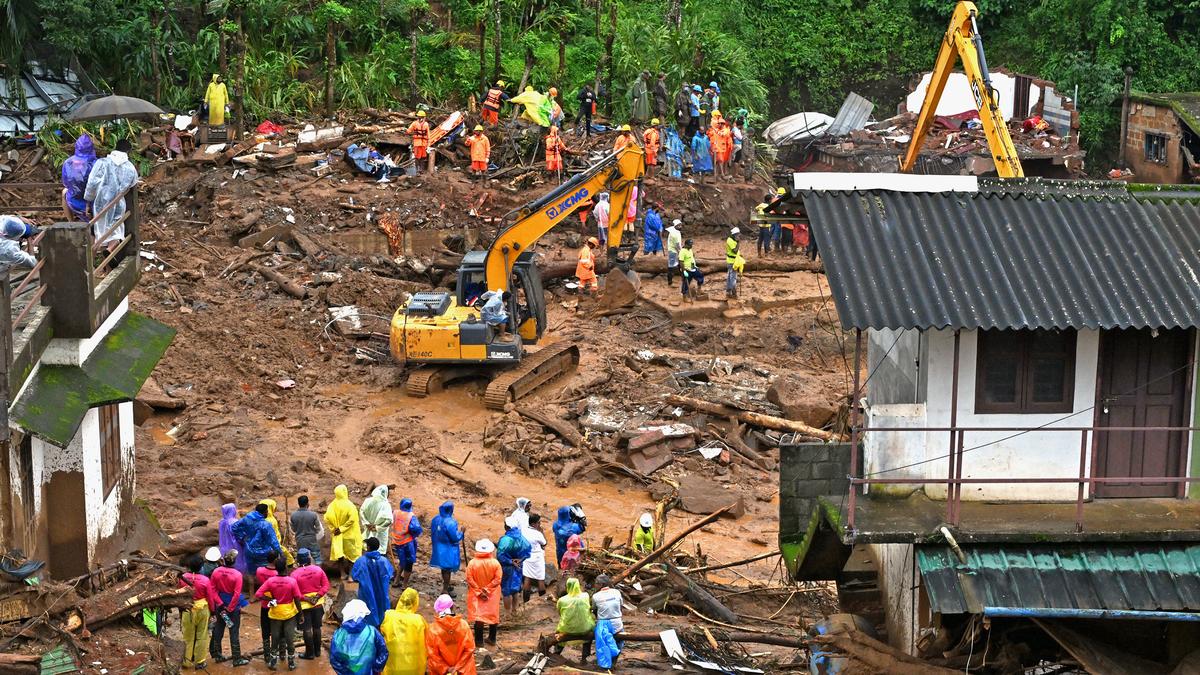Salient Features of World Physical Geography; Important Geophysical phenomena (earthquakes, tsunami, volcanoes, cyclones); Geographical features and location; Critical geographical features, flora, fauna (changes and effects thereof), Disasters & Disaster Management
In NEWS: Lessons from Wayanad, Himachal: As climate change intensifies, how to prepare for extreme weather events
Bring out the causes of frequent landslides in mountain ecosystems in India. Suggest suitable measures to prepare for such events.
A massive landslide in Kerala’s Wayanad that affected several villages underscores the urgency of understanding and mitigating landslide risks. According to ISRO’s Landslide Atlas of India, India is among the top four countries with the highest landslide risk.
Causes of frequent landslides in mountain ecosystems:
I Natural factors:
- Steep Slopes: The steep gradients of these mountain ranges make them inherently unstable. Example: The Himalayas, with their towering peaks and steep valleys, are particularly susceptible to landslides.
- Loose Soil: The presence of loose soil and unstable rock formations can easily be dislodged. Example: The Western Ghats, with their weathered and friable rocks, are prone to landslides.
- Heavy Rainfall and cloudbursts: The monsoon season brings heavy rainfall, saturating the soil and increasing the risk of landslides. Example: Cloudburst triggered landslides and floods in Itanagar, Arunachal Pradesh recently.
- Seismic Activity: Earthquakes can destabilize slopes and trigger landslides. Example: The 2015 Nepal earthquake triggered numerous landslides in the Himalayan region.
- Glacial Melt: The melting of glaciers in the Himalayas can increase water flow and erosion, leading to landslides. Example: The melting of glaciers in the Gangotri region can contribute to increased water pressure and soil erosion, leading to landslides.
- Climate change has exacerbated the risk by intensifying rainfall patterns and leading to more frequent and severe extreme weather events.Example: As per World Weather Attribution (WWA) group Climate change made the rainfall that triggered the recent Wayanad landslides in north Kerala 10% heavier
II Human-Induced Factors
- Deforestation: Clearing forests for agriculture, logging, or development can lead to soil erosion and loss of vegetation cover, making slopes more vulnerable to landslides. Example: Deforestation in Western Ghats triggered Wayanad landslide..
- Unsustainable Land Use: Unscientific farming practices, such as terracing without proper erosion control,monocropping can contribute to landslides. Example: Improper terracing in the Western Ghats and monocropping of tea and coffee lead to soil erosion and landslides.
- Infrastructure Development: Construction of roads, dams, and tunnels can disrupt the natural drainage patterns and trigger landslides. Example: The construction of roads in the Himalayas has sometimes led to landslides due to improper slope stabilization.
- Mining: Mining activities, especially in fragile mountain ecosystems, can weaken the structural integrity of slopes. Example: Illegal mining in the Himalayas has been linked to landslides in several areas.
India’s preparedness to deal landslides:
- Regulations should be strictly followed in the development planning for ecologically sensitive areas, properly taking into account environmental impact assessments, and the ecological footprints of projects.
- Need for a more robust and localised early warning system that can provide accurate, timely, and actionable alerts.
- A measure of subsurface water dynamics is crucial for understanding landslide risks in regions like the Western Ghats.Therefore, more sophisticated hydrological models should be developed.
- In addition to technological enhancements, improved coordination between government agencies and local communities to ensure that early warnings translate into effective early actions
- Disaster preparedness plans: Prepare and implement comprehensive disaster preparedness plans at local, state, and national levels.
- Automated weather stations should be established under each gram panchayat and urban local bodies to ensure timely evacuation and quick response to disasters.
- Land use planning: Implement sustainable land use planning to avoid construction in landslide-prone areas and promote afforestation.
- Slope stabilization: Employ engineering techniques such as slope stabilization, retaining walls, and drainage systems to reduce the risk of landslides
A comprehensive approach that addresses both natural and human-induced factors is essential for effective landslide mitigation. By implementing a combination of preventive measures, early warning systems, and disaster preparedness strategies, India can reduce the impact of landslides and protect its vulnerable communities.
| PYQ: How can the mountain ecosystem be restored from the negative impact of development initiatives and tourism? 2019 GS1 Bring out the causes for more frequent landslides in the Himalayas than in Western Ghats. 2013 GS 1“The Himalayas are highly prone to landslides.” Discuss the causes and suggest suitable measures of mitigation.2016 GS 1Differentiate the causes of landslides in the Himalayan region and Western Ghats.2021 GS 1 |

